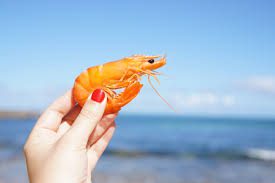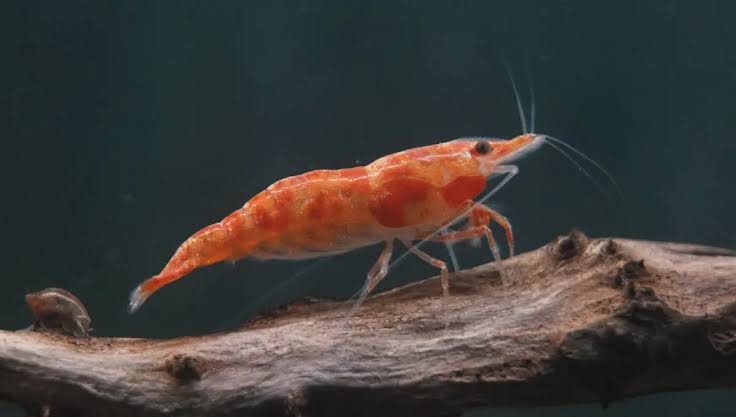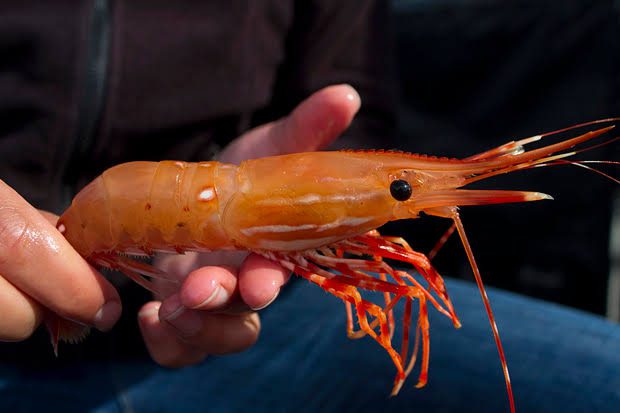Shrimp are small animals that live in the water. They have a hard outside shell called an exoskeleton. Shrimp come in different colors like pink, brown, or gray. Some people call them “seafood” because they are often caught and eaten.
These little creatures are found in oceans, rivers, and even some freshwater lakes. They like to live in places with lots of hiding spots, like under rocks or in coral reefs. Shrimp are very good at hiding because their colors help them blend in with their surroundings.
Shrimp eat tiny things like algae, plankton, and even smaller shrimp! They use their small legs to grab their food and bring it to their mouths. Some shrimp are very tiny, while others can grow to be a few inches long.
People catch shrimp for food in different ways. Some use big nets, and others use small traps. Shrimp is a popular food in many countries. People cook them in various ways, like boiling, frying, or grilling. Some enjoy eating shrimp with sauces or in salads.
Shrimp are interesting creatures because they can molt, which means they shed their hard shell as they grow. After molting, they have a soft shell that slowly hardens again. This process helps them grow bigger.
Sometimes, shrimp are not just food for people. They are part of the food chain in the water. Many other animals, like fish and birds, eat shrimp as a part of their diet. Shrimp play an important role in keeping the balance of life in oceans and rivers.
In some places, people farm shrimp. They create special pools where shrimp can grow in controlled conditions. This farming helps meet the demand for shrimp without taking too many from the wild.
Shrimp are fascinating creatures that play different roles in nature and human life. From their small size to their hiding skills, these little sea creatures are a vital part of the aquatic world.
Shrimp have interesting ways to communicate with each other. They use movements and even change colors to signal things to other shrimp. Sometimes, they flick their tails or use their antennae to send messages.
These creatures are quite social and live in groups called “schools” or “swarms.” Being together helps them protect themselves from predators. Sometimes, they create a chain by holding onto each other, which makes it harder for predators to catch them.
Shrimp have a short lifespan, usually living for about one to two years. During their lifetime, they go through different stages of development. They start as tiny larvae, then grow into juveniles, and finally become adults.
One interesting thing about shrimp is their ability to adapt to different environments. They can live in waters with varying temperatures and levels of saltiness. This adaptability helps them survive in different parts of the world.
Unfortunately, some shrimp face threats in their habitats. Pollution, overfishing, and changes in the environment can affect their populations. It’s important to take care of their habitats to ensure these fascinating creatures continue to thrive.
Overall, shrimp might seem small, but they have a big impact on the ecosystems they live in. They are not just tasty seafood; they’re also vital to the balance of life in the waters they inhabit. Understanding and protecting these creatures is crucial for the health of our oceans and rivers.
Read Also: The Benefits of Subsistence Farming
Appearance and Features of Shrimp

Shrimp have a distinctive appearance with their curved bodies covered by a hard exoskeleton. They typically have long, slender bodies with multiple segments and ten legs. Their front pair of legs are the largest, and they use these to catch food and sometimes even for communication.
Their color can vary greatly, spanning from shades of pink, brown, and gray to more vivid tones like red or green. Some have spots or stripes, while others might be more translucent. This variety in color helps them blend into their surroundings, providing camouflage against predators.
One of their notable features is their ability to molt. When they outgrow their exoskeleton, they shed it and emerge with a soft shell that gradually hardens again. This molting process allows them to grow throughout their lifespan.
Shrimp also have specialized appendages called antennae, which they use for sensing their environment. These antennae can detect changes in water movement, locate food, and even communicate with other shrimp. Their eyes are on stalks, providing them with a wide range of vision to spot potential dangers or prey.
Despite their small size, usually ranging from a few centimeters to a few inches, shrimp are remarkable creatures with unique adaptations that help them thrive in various aquatic environments.
Health and Lifespan of Shrimp

Shrimp, like many living organisms, can face health challenges and have a limited lifespan.
In terms of health issues, shrimp can be susceptible to diseases caused by viruses, bacteria, or parasites. These ailments can affect their growth, reproduction, and overall wellbeing. Factors like water quality, temperature changes, and overcrowding in shrimp farms can contribute to these health problems.
Their lifespan is relatively short, usually spanning from one to two years. However, this can vary based on the species of shrimp and their environment. They go through different life stages, starting as larvae and progressing through juvenile and adult stages during their relatively brief lifespan.
To ensure healthier shrimp populations, proper management of their habitats, maintaining good water quality, and implementing responsible farming practices are essential. These measures can help mitigate health issues and contribute to sustaining their populations in both natural and farmed environments.
Read Also: The Benefits of Agribusiness
Nutrition and Feeding Mode of Shrimp

Shrimp have a varied diet consisting of tiny organisms like plankton, algae, and small aquatic creatures. They use their specialized front legs to catch and eat their food. These legs have small appendages that act like hands, allowing them to grab onto their meals and bring them to their mouths.
Nutritionally, shrimp are a good source of protein, low in fat, and provide essential nutrients like vitamins and minerals. They contain omega-3 fatty acids, which are beneficial for heart health. Shrimp are also rich in selenium, a mineral important for antioxidant function in the body.
For humans, shrimp are considered a healthy seafood option. They are low in calories and high in protein, making them a popular choice for various diets. People cook shrimp in different ways—boiling, grilling, frying, or adding them to salads or pasta dishes—to enjoy their nutritional benefits and unique taste.
Shrimp’s popularity in human diets has led to various culinary creations worldwide. Their mild flavor makes them versatile, allowing them to blend well with different seasonings, sauces, and cooking methods. From classic dishes like shrimp scampi to exotic delicacies in various cultures, shrimp play a significant role in diverse cuisines.
The global demand for shrimp has led to both wild capture and aquaculture (shrimp farming). Aquaculture has become increasingly popular to meet this demand. Shrimp farms create controlled environments where these creatures can grow, ensuring a steady supply for markets and consumers.
However, shrimp farming also faces challenges. Issues such as disease outbreaks, habitat destruction, and environmental concerns related to water quality and waste management have emerged. Efforts are ongoing to develop sustainable practices in shrimp aquaculture, aiming to minimize these negative impacts on the environment.
Despite these challenges, shrimp remain a popular and sought-after seafood choice, appreciated for their taste, nutritional value, and culinary adaptability across various cultures and cuisines. Proper management and sustainable practices are essential to ensure a balance between meeting the demand for shrimp and preserving the health of aquatic ecosystems.
Importance of Shrimp
Shrimp serve various important roles in both natural ecosystems and human activities.
In ecosystems, shrimp contribute to the food chain. They serve as a food source for many other aquatic creatures like fish, birds, and larger invertebrates. Their presence helps maintain the balance of the ecosystem by controlling populations of smaller organisms and providing essential nutrients to predators.
For humans, shrimp hold economic importance as a valuable seafood commodity. They are a source of livelihood for fishermen and play a significant role in the global seafood industry. Shrimp are consumed worldwide and are an essential part of numerous cuisines, contributing to cultural dishes and culinary diversity.
Furthermore, shrimp farming or aquaculture has become a significant industry, providing a steady supply of this seafood delicacy. This farming supports local economies and provides employment opportunities in many regions.
Beyond their value as food, shrimp are also used in scientific research. Their adaptability to different environments and relatively short lifespan make them useful for studying various biological and environmental aspects.
However, as with any natural resource, responsible management is crucial to ensure sustainable use. It’s essential to balance the demand for shrimp with conservation efforts to protect their habitats and maintain healthy populations for future generations.
Economic Benefits of Shrimp
Shrimp contribute significantly to global economies through various means:
1. Commercial Fishing: Shrimp fishing is a substantial industry, providing income to fishermen worldwide. It supports livelihoods in coastal communities and contributes to the economic growth of regions reliant on fishing activities.
2. Export and Trade: Shrimp are a valuable seafood export commodity. Many countries rely on shrimp exports to generate income and support their economies. This trade fosters international relations and contributes to the global economy.
3. Employment: Shrimp farming and processing provide employment opportunities for a considerable number of people, from farmers tending to shrimp ponds to workers in processing plants and the transportation sector involved in moving shrimp products to markets worldwide.
4. Support Industries: The shrimp industry supports various auxiliary sectors such as packaging, equipment manufacturing, and seafood processing technology. This creates additional employment opportunities and stimulates economic growth in related industries.
5. Tourism and Culinary Sector: In areas known for their shrimp production, culinary tourism often thrives. Restaurants, culinary tours, and festivals centered around shrimp dishes attract tourists, boosting local economies through increased spending.
The economic benefits derived from the shrimp industry contribute significantly to the GDP of many countries, playing a crucial role in sustaining livelihoods and supporting economic development. However, it’s essential to balance economic gains with sustainable practices to ensure the long-term health of shrimp populations and their ecosystems.
Read Also: Importance of Good Personal Hygiene
